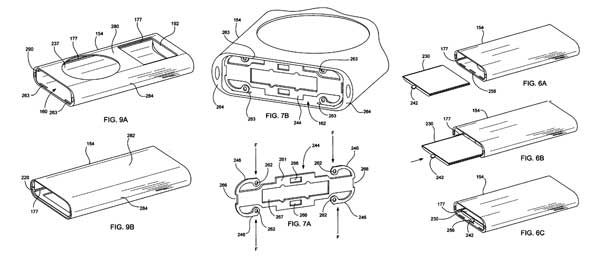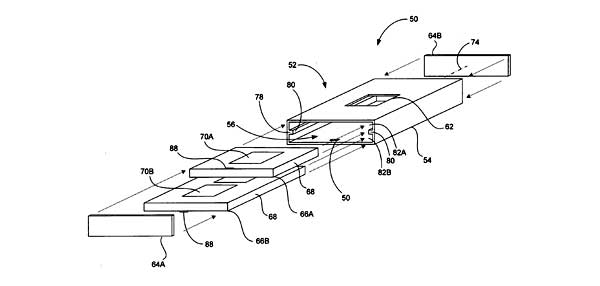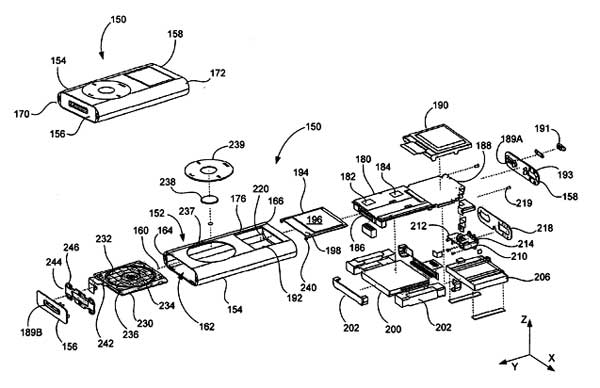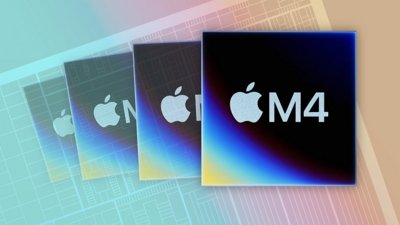Apple Computer in a new patent filing discloses that it has been experimenting with consumer electronics casing designs comprised of radio-transparent ceramic materials such as zirconia, which would allow wireless signals to pass through the enclosure and potentially enhance transmissions.
"This is especially important for wireless hand held devices that include antennas internal to the enclosure," Apple said. "Radio transparency allows the wireless signals to pass through the enclosure and in some cases enhances these transmissions." Cermaics would also allow for a "a smaller and cheaper antenna may be used" which could be "integrated with other components and placed at almost any location within the enclosure," making devices smaller and reducing manufacturing costs.
Other reasons for using ceramics cited in the filing are that they are highly scratch resistant, have color embedded in it (no paint or coatings), can be made into a wide variety of colors, and provide a variety of surface finishes including smooth and rough. Additionally, the Cupertino, Calif.-based company said the density of ceramics is typically higher than other materials, which would make for heavier electronics devices that feel more robust and exude greater quality.
In the filing, Apple noted that ceramics have been used in a wide variety of products, including electronic devices such as watches, phones, and medical instruments.
"In all of these cases, however, the ceramic material have not been used as structural components. In most of these cases they have been used as cosmetic accoutrements," the company said. "It is believed up till now ceramic materials have never been used as a structural element including structural frames, walls or main body of a consumer electronic device, and more particularly an enclosure of a portable electronic device such as a media player or cell phone."
Apple added that zirconia casing can be applied to a handheld computing device, cell phone, or iPod digital music player, and could come in a variety of colors including white, black, navy blue, ivory, brown, dark blue, light blue, platinum, and gold. "The colors may for example be created by adding doping materials to the ceramic material," it wrote. "Other materials may also be added including Yttrium, which helps keep the crystalline structure intact across all temperatures especially for maintaining strength as the part cools down."
In some cases, Apple said it may be necessary to applying a protective coating or protective features to the outside of the ceramic enclosure. "The coatings or features may for example be formed from deformable materials such as silicon, foam or rubber materials," the company said. "The coatings or protective features are typically positioned on the exterior surface to prevent cracking and protect the ceramic shell from undesirable forces as for example when the ceramic shell is dropped."
Also covered by the filing are methods of manufacturing a consumer electronics device with the said enclosures. One method "may include extruding a tube, cutting the tube to a desired length, forming one or more access openings in the face of the tube, inserting a user interface assembly into the tube, and thereafter locating and supporting the user interface assembly behind the access openings."
"The ceramic material may be in a form ready for forming or it may be in a raw state," Apple said. "If in a raw state, raw material processing is typically performed to ready it for forming. For example, a co-precipitation method may be performed in order to produce Y2O3 stabilized zirconia."
Although not shown in the filing, the iPod maker said internal components of some of the described devices could include support for FM, RF, Bluetooth, and 802.11 wireless frequencies.
"In one embodiment, the device is or includes functionality for supporting cellular or mobile phone usage," the company said. "In this embodiment, the device includes processors, transmitters, receivers, and antennas for supporting RF, and more particularly GSM, DCS and/or PCS wireless communications in the range of about 850 to about 1900 MHz."
The filing is credited to Apple employees Stephen Zadesky and Stephen Lynch.
 AppleInsider Staff
AppleInsider Staff









-m.jpg)






 Malcolm Owen
Malcolm Owen
 William Gallagher
William Gallagher
 Andrew Orr
Andrew Orr









-m.jpg)




100 Comments
This is just more proof that an iphone os some other consumer electronicts is in the works. the matereial sounds cool though notice that the two people who this patent is credited to both have a first name of steve. think they are on to something
notice that the two people who this patent is credited to both have a first name of steve. think they are on to something
Or, Apple is only hiring people named Steve. Or, MAKING THEM change their names TO Steve!
\
I don't get it. As Apple itself noted, ceramics are fairly brittle, so they need protective coatings or bumpers in the structural applications Apple envisions. They may be stiffer than plastic, which is also radio transparent, but also a heck of a lot more expensive.
And before anybody gets all excited about a blingy new iPod, that would take cubic zirconia, the crystalline version that they use in jewelry. Apple's talking about the ceramic substance.
Wireless transmission as in bluetooth is something the iPod has so far only had as an add on (mostly to connect wireless earphones). This technology could be used in a phone, but it's more important for wirelessly adding music to the iPod from your computer's iTunes library. Which is what many people believed the Zune was offering.
Plus zirconia means they can sell them on QVC!